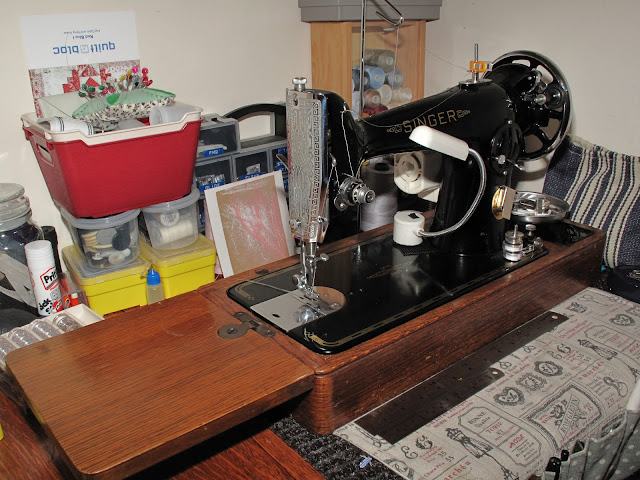First, an admission. I originally drafted this post back in late 2017, but did not post it. So I have edited and added to it and so, five years late almost, here it is.
I learned to sew on my Toyota SJ34, a modern, lightweight, 34 stitch, straightforward, easy to use, mechanical sewing machine with a wealth of features for beginner to intermediate users. I did what most people do today, learned on a modern machine costing close on £200 complete with the extension table.
I learned to sew on my Toyota SJ34, a modern, lightweight, 34 stitch, straightforward, easy to use, mechanical sewing machine with a wealth of features for beginner to intermediate users. I did what most people do today, learned on a modern machine costing close on £200 complete with the extension table.
This is what I sew on most of the time, now in 2022.
This is my 1940 Singer 201K, complete with bed extension, that I purchased earlier in 2017 as a hand-cranked machine, with two full sets of "Black tin" attachments and a third-party zig-zagger.
I have modified the machine a little, as follows: added a YDK 0.45amp motor, added a Chinese industrial 30 LED flexible neck lamp, clamped a bobbin on to the spool pin using a "wonder clip" to enable the bobbin to act as a thread guide for when I use spools of thread that are "cross-wound" from the thread stand that is behind the machine.
Now for the kicker........ This machine cost me £15 (Yes you read it correctly, £15), the LED lamp £4, new motor £31, thread stand £12. So the total outlay for the machine was £62. I cleaned and lubricated the machine myself to get it running really smoothly. Other than de-fluffing and lubricating I doubt that there will be any further need for a major outlay for servicing or parts for a long long time. This machine is built like a tank from all metal parts other than the bobbin wheel and drive belt and is more than capable of lasting another 50 years in domestic use, and it sews extremely well.
I have modified the machine a little, as follows: added a YDK 0.45amp motor, added a Chinese industrial 30 LED flexible neck lamp, clamped a bobbin on to the spool pin using a "wonder clip" to enable the bobbin to act as a thread guide for when I use spools of thread that are "cross-wound" from the thread stand that is behind the machine.
Now for the kicker........ This machine cost me £15 (Yes you read it correctly, £15), the LED lamp £4, new motor £31, thread stand £12. So the total outlay for the machine was £62. I cleaned and lubricated the machine myself to get it running really smoothly. Other than de-fluffing and lubricating I doubt that there will be any further need for a major outlay for servicing or parts for a long long time. This machine is built like a tank from all metal parts other than the bobbin wheel and drive belt and is more than capable of lasting another 50 years in domestic use, and it sews extremely well.
I have now (2022) been using my Toyota and Singer 201K for 8 and 5 years respectively. The 201K has been my main machine during this period for several reasons:
It is very, very quiet, even with its after market motor that replaces the original hand crank.
It is fast when I need it to be and very controllable down t o very slow. (Unlike the Toyota and many budget modern machines).
The stitch is excellent.
I have found a period buttonhole attachment which was the missing link to all I need in a machine.
But best of all is, at 82 years old this superb machine just fits how I work with a sewing machine. A few drops oil occasionally and a little routine maintenance has kept it "Singing" for the past 5 years that I have owned it. It rarely gives me any issues because I took the time, when I first bought it, to clean it thoroughly, really understand how it works and how to keep it in tip top working order ever since. For this I have been rewarded with a machine that any seamstress would love and be proud to own.


Comments
Post a Comment